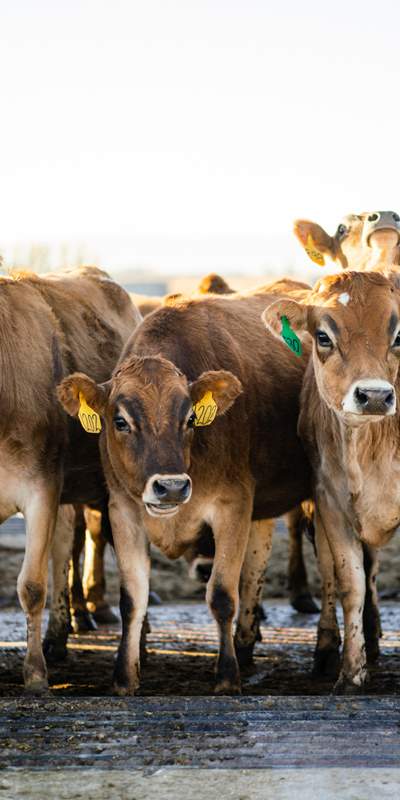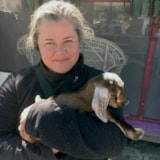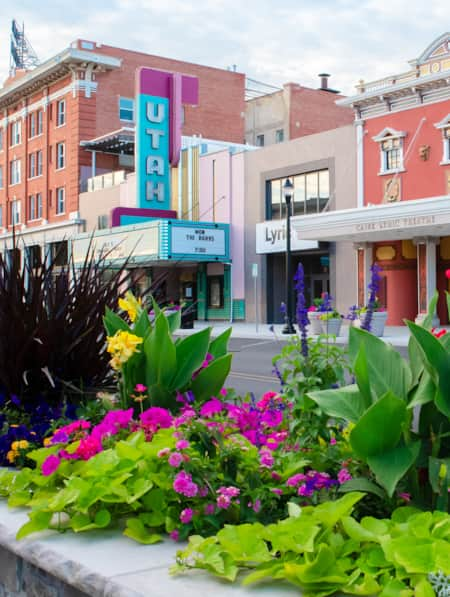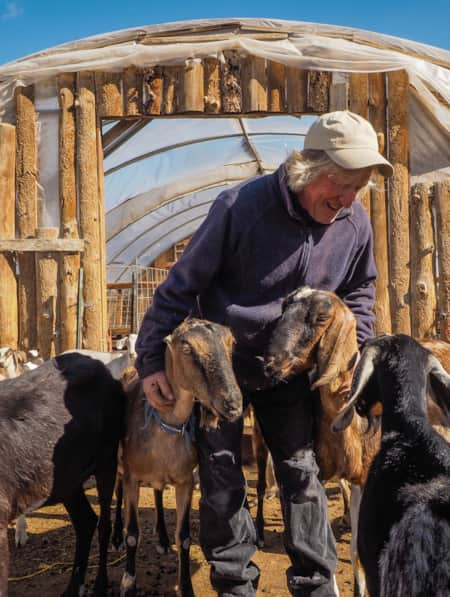Utah's Dairy Dynasty
The history of this ‘holey’ cheesemaking champion is anchored by Cache Valley’s rich family agriculture traditions.

Swiss cheese is so iconic as a type that it visually represents cheese as a food category in everything from the earliest cartoons to your phone’s keyboard emoji. Its ubiquitous holey appearance is used as an analogy describing medical conditions or the inadequacy of a legal argument.
And in an ironic twist of modern cheesemaking history, for a time in the late 20th century the biggest producer of Swiss-style cheese in the world wasn’t based in Switzerland at all: It was manufactured in northern Cache Valley by a Swiss immigrant named Edwin Gossner.
Fortunately for visitors to this beautiful valley, the delicious legacy of that dairy dynasty lives on through the family-run company Gossner Foods, with operations based near Utah’s far northern border with Idaho. A must-do whenever I’m in the area is a pitstop at the Gossner Foods Store, which is adjacent to the cheese plant. Located just outside of Logan, the store looks like it was plucked right out of the Alps: gorgeous mountain views, flower boxes, brown wood shutters and an old Swiss proverb about the importance of farmers painted in a dramatic blackletter typeface on a wall near the shop’s entrance.
You good faithful farmers,
How are you valued by your country?
If God does not bless
and the farmer does not work,
I ask, who has something to eat?
Wandering the store, I fill my basket with sliced muenster, shredded cheddar, smoked cheese curds and tetra-packed shelf-stable chocolate milk (my kiddo’s favorite post-mountain biking refuel). Plus, they offer convenient deli containers filled with snackable cubes of creamy dill Havarti and the Old-World Swiss that made Gossner’s famous. I eyeball the ice cream flavors available today and plan on a scoop to go. There’s even a section of the reach-in cooler dedicated to the unique Alpine-style cheeses made by Rockhill Creamery, a nearby artisan cheesemaker in Richmond. (Read: “Meet the Women Leading Utah’s Food and Beverage Renaissance.”)
During the COVID-19 pandemic, I’m particularly grateful for this masked-up moment of normalcy. I feel fortunate to be able to procure delicious goodness produced by people living right here in Cache Valley, made with milk sourced from about 130 small, independently run family dairies in Northern Utah and Southern Idaho.
By the time I arrive back home in Salt Lake City an hour-and-a-half later, my deli container of 0.295 lbs. of Gossner’s famed Swiss is predictably empty, but my mind is brimming with questions. As much as I love to dork out about eating cheese, I realize that I’ve really never delved into the technicalities of what makes Swiss cheese, well, Swiss. And how did those established traditions of European cheesemaking translate to large-scale production in Utah in the last century?
I fire off a barrage of questions via email to Gossner Foods CEO Kristan Earl about her family history and Gossner Foods’ current production. While awaiting her reply, I fall down the always-fascinating rabbit hole of cheesemaking history and dairy science.

For a time in the late 20th century, Utah’s Gossner Foods was the world's biggest producer of Swiss-style cheese.
Photo: Austen Diamond
"I feel fortunate to be able to procure delicious goodness produced by people living right here in Cache Valley, made with milk sourced from about 130 small, independently run family dairies in Northern Utah and Southern Idaho. "

Located just outside of Logan, the Gossner Foods Store looks like it was plucked right out of the Alps.

The Holey History of Swiss Cheese
In Switzerland’s legendary cheesemaking traditions, several cow’s milk cheese varieties have a similarly robust flavor profile, including famed cheeses like Gruyère, L'Etivaz, Sbrinz and Vacherin Fribourgeois. The distinctive holey appearance (in the cheese industry, these holes are called “eyes”) of what most Americans think of as Swiss cheese is most associated with the regional cheeses of Emmental and Appenzell, which are but a couple of the dozens of types of cheese made in the West Central region of Switzerland since the late 13th century.
The apocryphal story of why Emmental cheese has holes in it has something to do with particles of hay serendipitously falling into a long-ago milk bucket causing extra bacterial growth. That in turn created bubbles of gas in the soft cheese as it aged, making it holey.
In modern cheesemaking practice, a bacterial culture starter (usually Propionibacterium shermanii) is added to the milk vat at the start of cheesemaking while the milk is being warmed. This vigorous bacterium consumes lactic acid and releases carbon dioxide gas, which creates the air bubbles that become trapped in the rind of the cheese, making “eyes” as the wheel ages. An additional happy biproduct of the bacteria/CO2 relationship is when lactic acid is converted to propionic acid, which is the component that gives Emmentaler it's unique nutty flavor and pungency.
Cheesemakers figured out that they could control the size and distribution of the eyes by manipulating factors like the acidity and temperature of the milk and the aging time of the wheel. Experts note that one unique characteristic of 'holey' cheeses, such as Emmentaler, is that what you taste is often reflected in what you see: Larger eyes typically indicate that the cheese has aged longer, and the propionic acid has had time to do all of its flavor-boosting work.
So, smaller air pockets can indicate mild and creamy flavors (think American Baby Swiss) while European cheeses with big eyes will also have bigger, more robust, rich and sometimes funky flavors. What Americans typically see in the deli case labeled as Swiss cheese is a catch-all term for any kind of cheese speckled with holes; tasty, for sure, but generally not as pungent as Emmentaler.

In 1965, Edwin Gossner left the Cache Valley Dairy Association plant to launch Gossner Foods, finally achieving his dream of owning his own cheese company.


Utah’s Little Switzerland
Between 1850 and 1900, more than 18,000 white settlers moved into the greater Cache Valley drawn by promise of the rich alluvial soils of the valley floor and irrigation potential of the Bear River and its tributaries. They had followed in the decades after the arrival of fur trappers along the Bear River in the early 1800s, and the violent military removal of the Shoshoni people from the valley.
Many of the region’s earliest white settlers were European immigrants hailing from countries with established dairy farming traditions, which sparked Cache Valley’s boom as a dairying region in the late 19th century. Local farmers often pooled their milk supplies through cooperatives, which in turn produced cheese and butter.
By 1912, the Cache Valley was so established as a major western dairy region that the community launched a show and auction now known as the Western Heritage Holstein Cattle Show. It’s celebrated locally each May with a multi-day festival in Richmond called Black and White Days — now the longest running Holstein cattle show west of the Mississippi.
When fourth-generation dairy farmer Lacey Papageorge described the festival to me, her eyes lit up. “Black and White Days is one of the biggest highlights of my family’s year.” From the hundred or so Holsteins at her family’s Pappys Farms Dairy (they’re also one of Gossner Foods’ local milk suppliers), the Papageorges’ pick their top contenders for the show.
“We shave their hair and get them all pretty,” she says of preparing both heifers and milk cows for showing. In addition to the awards and recognition that Pappys Farms wins, Papageorge says: “A lot of the dairy community comes together, and we get to celebrate our best animals; it’s a really special time.”
“We have this great circular economy with Utah agriculture, where we're all working together,” says Papageorge, who is the farmer relations manager for the Dairy West nonprofit. “And a lot of this relates to sustainability,” she says, explaining that dairy manure may be used as a natural fertilizer for a crop farmer’s soil, and in turn the beet pulp byproduct from sugar making goes back to feed dairy cows. And then dairy farming and cheesemaking provide jobs for hundreds of people living in Cache Valley. The longstanding dairy heritage is further celebrated by the newly launched Cache Valley Cheese & Dairy Festival, an annual event which kicked off in September 2021.
"By 1912, the Cache Valley was so established as a major western dairy region that the community launched a show and auction now known as the Western Heritage Holstein Cattle Show. It’s celebrated locally each May with a multi-day festival in Richmond called Black and White Days — now the longest running Holstein cattle show west of the Mississippi."

Edwin Gossner: A Cheesemaking Visionary
The youngest son of nine children, Edwin Othmar Gossner was born in 1908 in Eastern Switzerland, where his family had been farming near Waldkirch for generations. Knowing that his older brother would inherit the family farm, Gossner applied for a U.S. visa in 1930 and traveled by boat to New York with the intention to join his brother Ernest, who was managing a cheese plant in Wisconsin. With only the clothes on his back and speaking no English, Ed Gossner used all the money he had left to buy a train ticket to Wisconsin and two apples, his only sustenance for the rest of the journey.
Ernest taught his brother how to make cheese using recipes and techniques handed down from Swiss cheesemakers, and eventually Ed became a master cheesemaker himself. He met and married Josephine Oechslin, and managed cheesemaking plants in Wisconsin and California.
During a family trip to Yellowstone National Park, Gossner visited Utah’s Cache Valley, a region known as “The Little Switzerland of the Rockies,” and he was immediately struck by the similarities to his homeland. In 1941, the Cache Valley Dairy Association hired Gossner to convert a failed beet sugar plant they’d purchased in the small town of Amalga into an operational cheese plant.
This collaboration resulted in Gossner making the first Swiss cheese in Utah in January of 1942, which he continued to do as the plant’s manager for the next 24 years. By the 1960s, this plant was the largest Swiss cheese factory in the world, contracting with 800 local dairy farmers and grossing over $10 million in annual sales.
In 1965, Gossner left the Cache Valley Dairy Association plant to launch Gossner Foods, finally achieving his dream of owning his own cheese company, with several family members in leadership positions. His daughter Dolores Wheeler took over as CEO in 1984. The company’s current CEO, Kristan Earl — Gossner’s great-granddaughter — explains that growing up in the family business was very hands-on: she worked on the family farm, helped in the retail outlet and eventually assisted her grandmother, Dolores Wheeler, in management, all while she was earning an agribusiness degree from Utah State University.
She was hired fulltime as a milk procurement specialist the same month she graduated. That job helped her understand how milk was priced, and how vital the success of local dairies were to her family’s company.
Now, Gossner Foods co-packs cheese with labels of some of the biggest dairy brands in the nation. Earl reiterates that no matter how large the operation is, cheesemaking is dependent upon sourcing quality raw ingredients. “Our farm families are the first step to producing quality milk, from which we craft quality cheese,” she says.
She’s inspired by her own family’s history, how her great-grandfather fell in love with the beauty of Cache Valley, while he also saw a business opportunity, based on paying better prices to local dairies. The company her ancestor founded still works with Pappys Farm, as well as some of the area’s other fourth- and fifth-generation family farms. “This contributes to the success of the rural lifestyle we enjoy,” Earl says.
It also happens to be really, really delicious.

Good Roots: The Faces of Utah’s Food Culture
Meet some of the agricultural entrepreneurs that are elevating the tastes of Utahns and visitors through heritage and best practices, new and old.
What's Nearby
-
Bear Lake State Park
Bear Lake is a 20-mile long and eight-mile wide natural lake with beautiful, placid waters that perfectly match the tranquil pace of the quaint towns that dot the shore. The northern half is located in Idaho and the southern half in Utah with the state lines dividing it.
-
Bear River Migratory Bird Refuge
This is the Bear River Migratory Bird Refuge, an eye-opening stop along Utah's populous Wasatch Front for any traveler and a top destination for any serious birder with gaps on their life lists.
-
Beaver
Beaver, with a population of 3,000, is a gateway to gorgeous landscapes, rivers and streams, miles of hiking and mountain biking trails, breathtaking scenic drives, haunted ghost towns, and plenty of peace and quiet.
-
Cherry Peak
Cherry Peak is located just 15 miles from Logan, near the Idaho border. The family-owned, nearly 400-acre resort, features three triple chairlifts, a comprehensive snowmaking infrastructure and a 1.25 mile-long run.
-
Hyrum Lake State Park
Willow, box elder and maple trees surround Hyrum Reservoir providing shade as well as habitat for waterfowl and wildlife.













